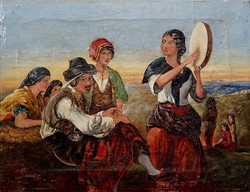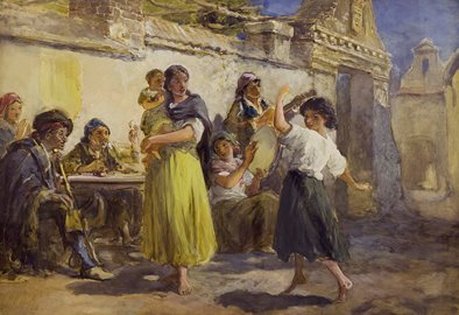A Group of Figures in a Spanish Street
|
Research by Christine Armstrong
|
|
ARTIST
Francis William (Frank) Topham, watercolour painter, was born in Leeds, Yorkshire, on 15 April 1808, the son of Richard Topham (1781–1834), pawnbroker, and his wife, Elizabeth Rawson (1784–1861). Apprenticed to his uncle, Samuel Topham, he was taught to engrave. In 1830 he moved to London to take up heraldic engraving before joining the publishing firm of Fenner and Sears as an engraver of title-pages and illustrations. This led to original illustrative work for books, including Sir Walter Scott's 'Waverley' novels, S C Hall's 'Book of Gems' (1836), George Tattersall's 'The Lakes of England' (1836) and, in 1869, for the Illustrated London News. In 1851 he engraved frontispieces for the three volumes of Charles Dickens', 'A Child's History of England'. In March 1832 Topham married Mary Anne Beckwith (1811–1873) of Clerkenwell, London, the sister of a fellow engraver, Henry Beckwith. They had ten children. His eldest son, Francis William Warwick (Frank) Topham (1838–1924), also a painter, married Helen Lemon, daughter of Topham’s friend, Mark Lemon, the first editor of Punch, on 3 May 1870. Soon after his arrival in London Topham joined the Artists' Society, which met in Clipstone Street, to draw models picked from street vagabonds. There he was recruited by Charles Dickens to join his amateur theatrical company, the Guild of Literature and Art. In addition to appearing in London, provincial theatres and several country houses, he frequently performed with Dickens before Queen Victoria. However, he continued to paint and soon chose peasant life as his favourite subject; his earliest works were of peasants from Wales and Ireland. He began to exhibit in 1832 and had seven paintings shown at the Royal Academy. In 1842 he was elected an associate of the New Society of Painters in Water Colours, becoming a full member the following year. He moved to the Society of Painters in Water Colours in 1848. In 1877 Topham, whose health had been failing, made a final visit to Córdoba in Spain, travelling with two friends. After being taken ill on the journey, he collapsed soon after arrival and died on 31 March and was buried in the protestant cemetery outside Córdoba. When that fell into dereliction he was reinterred, on 16 December 1959, in the municipal cemetery of San Rafael, where, in 1994, a nearby square was renamed plaza del Pintor Topham. Examples of his work are in the collections of the British Museum, the Victoria and Albert Museum, London, the Williamson Art Gallery and Museum, Birkenhead, Bury Art Gallery and Museum, Reading Art Gallery and Museum, the Ulster Museum in Belfast and the municipal collection in Córdoba. (Pocock, 2014) PAINTING The painting is of a typical Spanish peasant family scene. Topham toured Spain for the combination of landscape and architecture but the squalor of Spain appalled him. His larger Spanish works were painted from sketches on his return to London; his subjects being figures in brightly coloured native dress, (see painting below) in settings indicated by such titles as The Eve of the Fiesta, The Andalusian Letter-Writer and Spanish Gossip. French subjects dated from 1857 and Italian from 1864. His paintings commanded good prices from the growing urban middle class avid for colourful paintings of rural life. (Pocock, 2014) |
REFERENCES
Pocock, T, (2014), Francis William (Frank) Topham @ http://www.oxforddnb.com/view/article/27552 Ancestry (2014), England & Wales, National Probate calendar 1855-1966 for Samuel Topham @ http://www.ancestry.co.uk/ Ancestry (2014), England & Wales Death Index 1916-2007 for Samuel Topham @ http://www.ancestry.co.uk/ Image Wikimedia Commons (2014), Spanish Gypsies 1854 -1855.JPG @ https://commons.wikimedia.org/wiki/File:Spanish_Gypsies_1854_-_1855.JPG |

Spanish Gypsies - oil on canvas, 29.5 x 38.5 cm
Painted between 1854 and 1855
and held in a private collection.
(Wikimedia Commons, 2014)
Painted between 1854 and 1855
and held in a private collection.
(Wikimedia Commons, 2014)
DONORS
The donors, Samuel Topham and his wife, Helen, who did not have any children, lived at 62 Caryl Road, Lytham St Annes. The artist of the painting, Francis William (Frank) Topham, was Samuel's great-uncle. Samuel died on 4 November 1957 in Brentwood Nursing Home, St Annes (Ancestry 2014), having previously donated the painting in 1955. Samuel, who was born in Manchester, had earned his living as a pawnbroker, as had all his family going back four generations, who had lived in Leeds.
Samuel's parents were Charles Topham (1841-1909) and his wife, Sarah Jane, nee Read (1846-1918). They had a prosperous jewellery and pawnbroking business in Pendleton, Salford. On retirement they moved to Warbreck Road, Blackpool. Charles served as a Conservative Councillor for Claremont Ward 1905-1908.
The donors, Samuel Topham and his wife, Helen, who did not have any children, lived at 62 Caryl Road, Lytham St Annes. The artist of the painting, Francis William (Frank) Topham, was Samuel's great-uncle. Samuel died on 4 November 1957 in Brentwood Nursing Home, St Annes (Ancestry 2014), having previously donated the painting in 1955. Samuel, who was born in Manchester, had earned his living as a pawnbroker, as had all his family going back four generations, who had lived in Leeds.
Samuel's parents were Charles Topham (1841-1909) and his wife, Sarah Jane, nee Read (1846-1918). They had a prosperous jewellery and pawnbroking business in Pendleton, Salford. On retirement they moved to Warbreck Road, Blackpool. Charles served as a Conservative Councillor for Claremont Ward 1905-1908.

